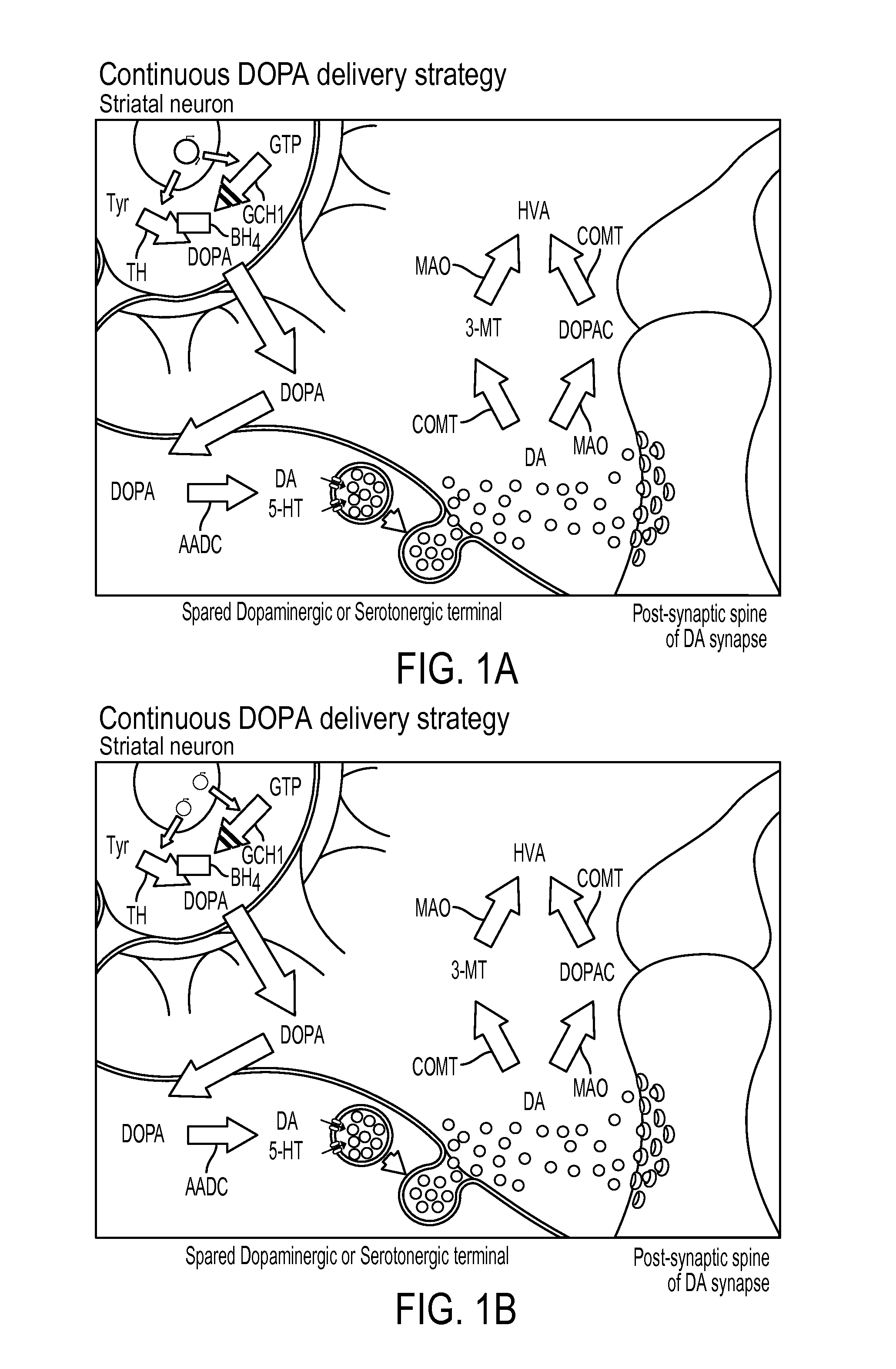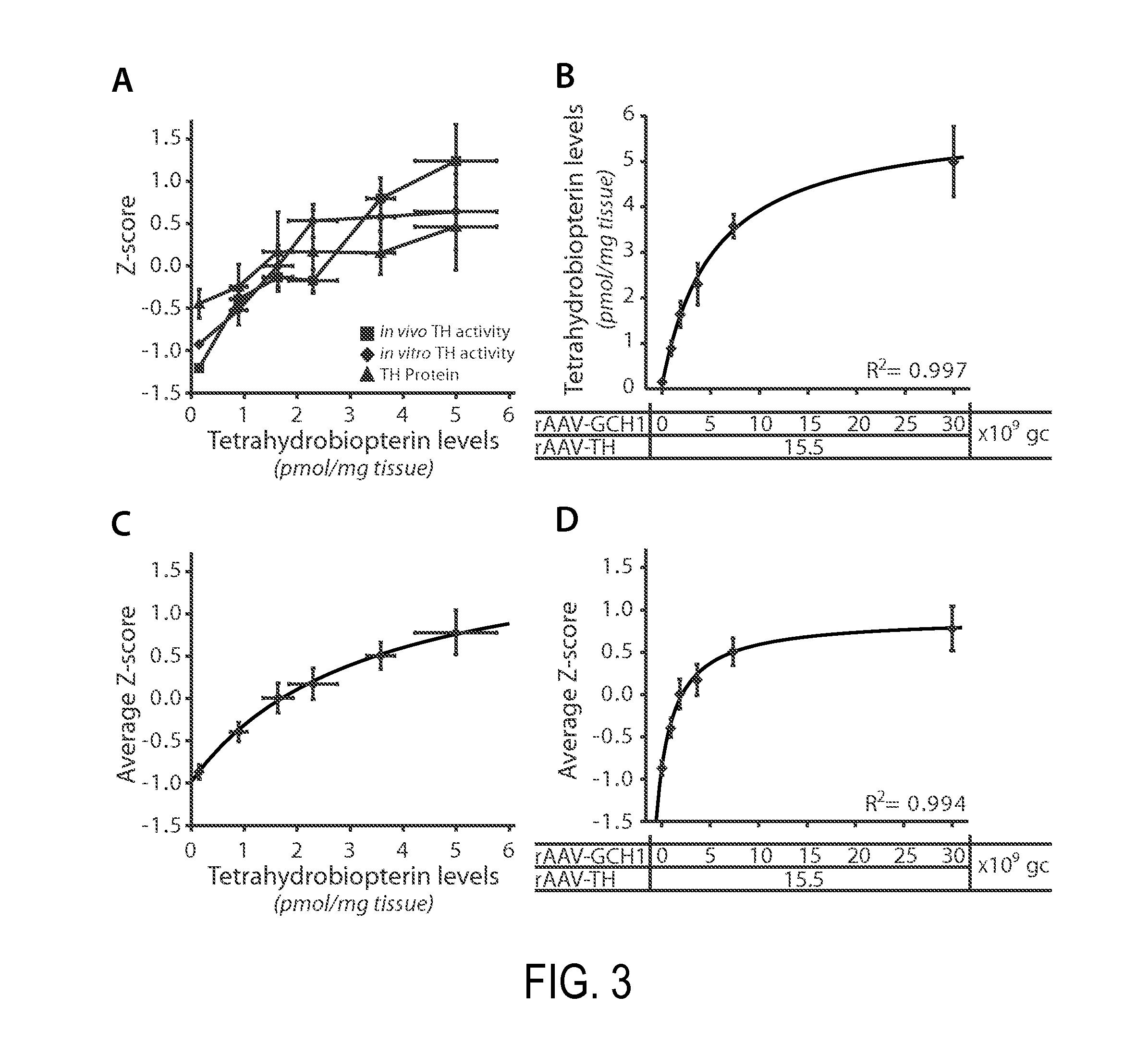Novel viral vector construct for neuron specific optimized continuous dopa synthesis in vivo
a technology of neuron specificity and continuous dopa synthesis, which is applied in the field of viral vector constructs especially single raav vector constructs, can solve the problems of increasing adverse events, diminishing treatment response of most patients, and l-dopa-induced dyskinesia, etc., and achieves the effect of reducing bias
- Summary
- Abstract
- Description
- Claims
- Application Information
AI Technical Summary
Benefits of technology
Problems solved by technology
Method used
Image
Examples
example 1
The Effect of a Single rAAV Vector for Continued DOPA Delivery in an Animal Model of Parkinson's Disease
Materials and Methods
Experimental Design
[0339]All rats in the experiment below (with the exception of animals in the intact control groups) received a unilateral injection of 6-OHDA into the medial forebrain bundle (MFB) to achieve a complete lesion of the nigrostriatal pathway. At four to five weeks post-lesion, all lesioned animals were screened in a rotation test after an amphetamine-induced rotation test [Ungerstedt and Arbuthnott: Quantitative recording of rotational behavior in rats after 6-hydroxy-dopamine lesions of the nigrostriatal dopamine system; Brain Res 1970 24 485-93]. Only animals exhibiting >6.0 full-body turns / min towards the DA depleted side were included in the study (n=54).
[0340]Twenty rats with a confirmed 6-OHDA lesion were balanced into two groups (Les-Sham and TH-GCH1) based on their performance in the cylinder tests and in amphetamine- and apomorphine-in...
example 2
Dosage Calculations
[0357]Findings in the rodent studies utilizing the single vector AAV mediated DOPA delivery in the rat model of complete dopamine denervation has enabled us to precisely determine the dose range required for functional recovery. Through careful evaluation, we have found that a dose of 9.1E8 gc GCH1-TH (defined as 0.7%, Table 1A) resulted in a significant recovery in 2 out of 10 animals in the corridor test. The next dose 4.6E9 gc GCH1-TH (3.4%) resulted in recovery in 8 out of 10 animals while the two highest doses tested, 1.3E10 gc GCH1-TH (9.8%) and 1.3E11 gc GCH1-TH (100%) enabled total recovery in 10 out of 10 animals in this test. The 100% dose however resulted in a more rapid recovery, complete already at three weeks post surgery.
[0358]For calculations on dosing equivalents in non-human primates and humans, a scaling factor for the putaminal region was calculated based on literature data on MR and histological evaluation (Table 1B). These data provide a scal...
example 3
Sequences Included in the Invention
[0368]SEQ ID NO 1: GTP cyclohydrolase 1 (human)
[0369]SEQ ID NO 2: GTP cyclohydrolase 1 Isoform GCH-2 (human)
[0370]SEQ ID NO 3: GTP cyclohydrolase 1 Isoform GCH-3 (human)
[0371]SEQ ID NO 4: GTP cyclohydrolase 1 Isoform GCH-4 (human)
[0372]SEQ ID NO 5: GTP cyclohydrolase 1 (rat)
[0373]SEQ ID NO 6: GTP cyclohydrolase 1 (mouse)
[0374]SEQ ID NO 7: Tyrosine 3-hydroxylase (human)
[0375]SEQ ID NO 8: Tyrosine 3-monooxygenase (human)
[0376]SEQ ID NO 9: Tyrosine hydroxylase (human)
[0377]SEQ ID NO 10: Tyrosine hydroxylase (human)
[0378]SEQ ID NO 11: Tyrosine 3-monooxygenase (human)
[0379]SEQ ID NO 12: Tyrosine 3-monooxygenase (human)
[0380]SEQ ID NO 13: Tyrosine 3-hydroxylase (rat)
[0381]SEQ ID NO 14: Tyrosine 3-hydroxylase (mouse)
[0382]SEQ ID NO 15: Adeno-associated virus 2 left terminal sequence
[0383]SEQ ID NO 16: Adeno-associated virus 2 right terminal sequence
[0384]SEQ ID NO 17: Homo sapiens synapsin 1 (SYN1) promoter sequence
[0385]SEQ ID NO 18: Homo sapiens GTP cyc...
PUM
| Property | Measurement | Unit |
|---|---|---|
| pH | aaaaa | aaaaa |
| pH | aaaaa | aaaaa |
| pH | aaaaa | aaaaa |
Abstract
Description
Claims
Application Information
 Login to View More
Login to View More - R&D
- Intellectual Property
- Life Sciences
- Materials
- Tech Scout
- Unparalleled Data Quality
- Higher Quality Content
- 60% Fewer Hallucinations
Browse by: Latest US Patents, China's latest patents, Technical Efficacy Thesaurus, Application Domain, Technology Topic, Popular Technical Reports.
© 2025 PatSnap. All rights reserved.Legal|Privacy policy|Modern Slavery Act Transparency Statement|Sitemap|About US| Contact US: help@patsnap.com



